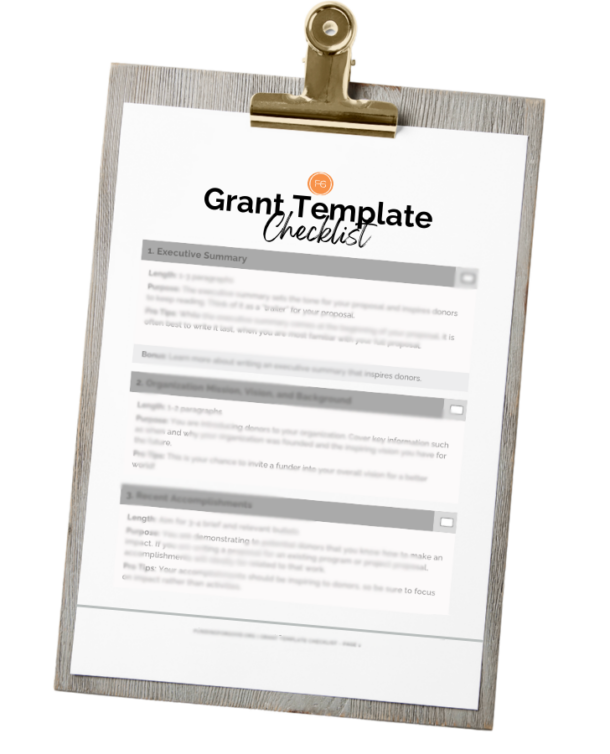Do you want to know the easiest way to set your development director or grant writer up for success?
Use Pre-Program Design to create a stellar program.
Pre-Program design, that’s right. Your grant writer can do everything else right. They can develop good relationships with foundation officers. Present complete financial reports. Craft a beautiful story to highlight your organization’s history and prior successes. As a matter of fact, they can check all these boxes, but that isn’t enough to secure dollars.
At the end of the day, your grant writer must have a well-written program design that captures a donor’s interest and compels them to act. Ths is accomplished with Pre-Program Design strategies.
Your organization might have the most gifted grant writer on earth. Still, they cannot be expected to “whip up a winning proposal out of thin air” any more than the world’s best jockey could be expected to win the Kentucky Derby riding a pony. -Marie Palacios
Your grant writer will appreciate it if you follow a few critical guidelines BEFORE you ask them to write a winning proposal.
Top 11 Tips for Pre-Program Design
1. NEVER create a program just to chase after grant funds
Grant funds are great to start a program, but rarely provide on-going support. Therefore only pursue funds for programs that your organization has thoughtfully considered. They should align with your mission statement and vision. Generally speaking they should help you achieve established strategic plan goals.
2. Confirm the need
Demonstrate a compelling need for action by your organization. For example, using relevant statistics and credible accounts from community leaders and members within your service area.
3. Conduct a community assessment BEFORE designing a new program
Have you identified a need or problem in your community? If so, the next step is to make sure your board/staff completes due diligence. Although you identified a need, other local entities may already be working to meet the need. For this reason proper due diligence is key.
4. Don’t duplicate. Be willing to partner to bridge gaps
Once you find a need within the scope of your mission, you might try to work alone. Don’t do it. For one thing, if the need is truly great, some other local groups are working on the same thing. With this in mind, get connected. Figure out how you can share resources and avoid duplicating services. In the long run this type of partnership helps your community leverage more funding for the project.
5. Collaboration NOT competition
Program funds are not as readily available as they were a decade ago. In particular, donors want to see how grantees can make the most impact with their dollars. Donors favor proposals that include strong community support and collaboration. If another entity is better positioned to take the lead on the program, are you willing to support their efforts?
6. Evaluate successful programs before designing your own
It’s no secret that evidence-based programs have a higher chance for success. To that end, reach out to experts in the field. Ask about any similar programs in the region, state, or nation that have a proven track record. Additinally, contacting program officers for tips on staffing, equipment, curriculum, capacity, service models, sustainability, etc. is helpful.
7. Outline your solution
Approach this “pre-design” task as a visioning session. Together with key members of your team and community, engage in a “visioning session”. The resulting session should gather input, brainstorm solutions, and achieve consensus about the program.
8. Evaluate Resources
Ask your team, “What resources are CRITICAL to meeting program goals? Work together to identify critical vs ideal resources. Specifically, consider things like human resources, adequate program space, supplies, materials and partnerships.
9. Who will do what?
Confirm if your staff has the time, energy, and expertise to effectively run the program. It’s equally important to refrain from ambiguous statements such as “current staff will assume responsibility for the program/project”. By all means consider current job descriptions. That said, don’t make the excuse of NOT hiring new/needed program staff when appropriate.
10. Define your target population
Be intentional about who the program is intended to serve. By the same token it’s important to determine if your organization has the credibility to engage your target audience. If not, can they gain that credibility?
11. Establish systems for tracking impact
Everyone must know the intended IMPACT of the program. Chiefly, how will success be tracked, measured and reported? You must know this Before your program can launch or your grant writer can craft a proposal. It is important to realize a program with a proven history of success is more likely to achieve long-term sustainability.
Have you have checked off all the above pre-program design tips? If so, are you ready to brainstorm and organize written components of the program design process? Check out our easy to use free tool:
“Grant in a Box: Where Program Design and Grant Planning Intersect”


